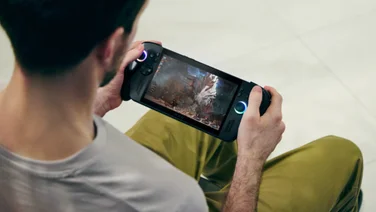Gaming

This is the Switch 2 deal I'd buy this Black Friday
If you're not sure which Switch 2 deal to buy this Black Friday, let this unabashed nerd help you out
-
 The PS5 Slim Digital Edition is cheaper than we’ve ever seen it this Black Friday Decided it’s time to step into the current generation of console gaming? Then you’ll want to take advantage of this Black Friday PS5 deal at EE
The PS5 Slim Digital Edition is cheaper than we’ve ever seen it this Black Friday Decided it’s time to step into the current generation of console gaming? Then you’ll want to take advantage of this Black Friday PS5 deal at EE -
 Lenovo Legion Go S (Windows/AMD Ryzen 2 Go) review: No-Go for demanding AAA games While it has some high points - the large, bright screen chief among them - the Legion Go S lacks the muscle to do justice to blockbuster AAA titles£549
Lenovo Legion Go S (Windows/AMD Ryzen 2 Go) review: No-Go for demanding AAA games While it has some high points - the large, bright screen chief among them - the Legion Go S lacks the muscle to do justice to blockbuster AAA titles£549 -
recommended
 Asus ROG Xbox Ally X review: How does the Xbox handheld measure up? Excellent hardware with impressive game performance, even if the Xbox software still needs a little work£799
Asus ROG Xbox Ally X review: How does the Xbox handheld measure up? Excellent hardware with impressive game performance, even if the Xbox software still needs a little work£799 -
 Asus ROG Xbox Ally review: The real Xbox experience in your hands? The ROG Xbox Ally gives you nearly everything that’s great about the premium Ally X, but may lack the performance to run the latest, greatest PC games£499
Asus ROG Xbox Ally review: The real Xbox experience in your hands? The ROG Xbox Ally gives you nearly everything that’s great about the premium Ally X, but may lack the performance to run the latest, greatest PC games£499 -
recommended
 MSI Claw 8 AI+ A2VM review: Massive handheld, massive power MSI’s monster handheld can manage more demanding PC games and deliver something close to a home console experience£899
MSI Claw 8 AI+ A2VM review: Massive handheld, massive power MSI’s monster handheld can manage more demanding PC games and deliver something close to a home console experience£899 -
 The Lenovo Legion Go 2 gets a release date at IFA 2025 And it’s going to hit shelves before the ROG Xbox Ally X – but should you wait?
The Lenovo Legion Go 2 gets a release date at IFA 2025 And it’s going to hit shelves before the ROG Xbox Ally X – but should you wait? -
 Asus ROG Xbox Ally X: Handheld hype intensifies, but we still don’t know how much it will cost Testing limitations and software restrictions at Gamescom left some key questions unanswered, but I’m excited for the release of the ROG Xbox Ally handhelds in October
Asus ROG Xbox Ally X: Handheld hype intensifies, but we still don’t know how much it will cost Testing limitations and software restrictions at Gamescom left some key questions unanswered, but I’m excited for the release of the ROG Xbox Ally handhelds in October -
 The Asus ROG Xbox Ally series is coming this October Here’s when you can get your hands on the new handheld consoles from Asus and Xbox
The Asus ROG Xbox Ally series is coming this October Here’s when you can get your hands on the new handheld consoles from Asus and Xbox -
recommended
 Boulies Master Gaming Chair review A lovely looking gaming chair with all the trimmings at a reasonable cost£370
Boulies Master Gaming Chair review A lovely looking gaming chair with all the trimmings at a reasonable cost£370 -
recommended
 Nintendo Switch 2 review: It’s a super-sized smash, bro The long-awaited Nintendo Switch 2 evolves the formula with more powerful hardware and a much better display – but battery life suffers£395
Nintendo Switch 2 review: It’s a super-sized smash, bro The long-awaited Nintendo Switch 2 evolves the formula with more powerful hardware and a much better display – but battery life suffers£395 -
 Nintendo Switch 2: Hands-on I go hands-on and (mostly) head-over-heels for the new Nintendo Switch 2 at London’s Excel exhibition centre
Nintendo Switch 2: Hands-on I go hands-on and (mostly) head-over-heels for the new Nintendo Switch 2 at London’s Excel exhibition centre -
 This is how much the Nintendo Switch 2 will cost you We finally know how much the Nintendo Switch 2 will cost, when it’s launching and what games you can play on day one
This is how much the Nintendo Switch 2 will cost you We finally know how much the Nintendo Switch 2 will cost, when it’s launching and what games you can play on day one -
 Nintendo FINALLY officially unveils the Switch 2 There's no official release date yet for the Switch 2, or a price, but Nintendo will reveal more information in April
Nintendo FINALLY officially unveils the Switch 2 There's no official release date yet for the Switch 2, or a price, but Nintendo will reveal more information in April